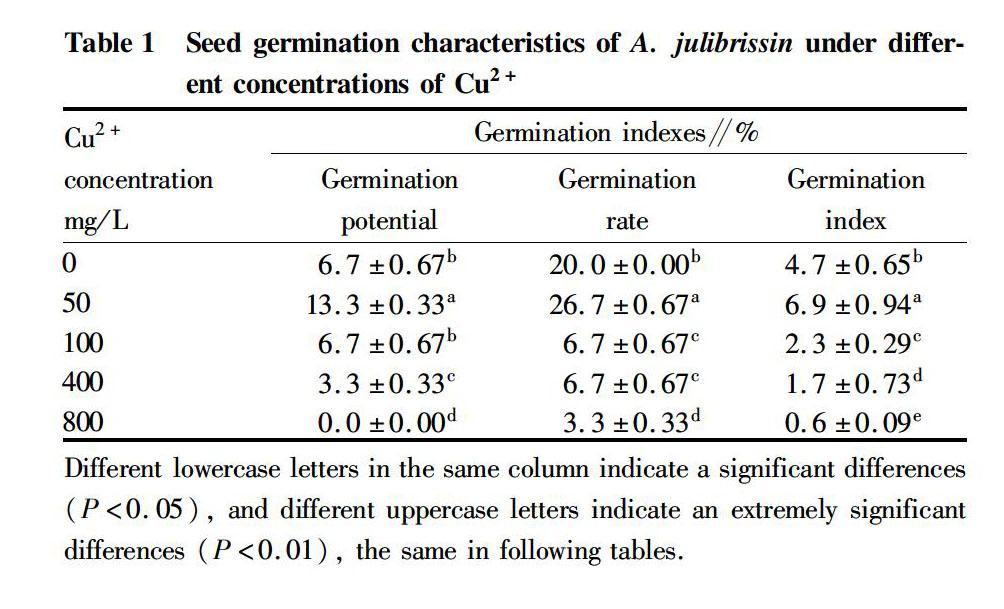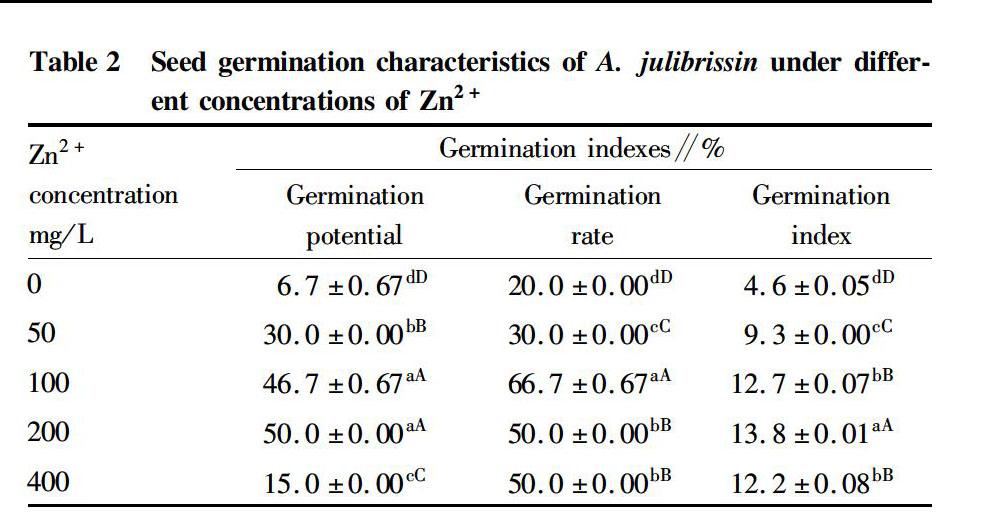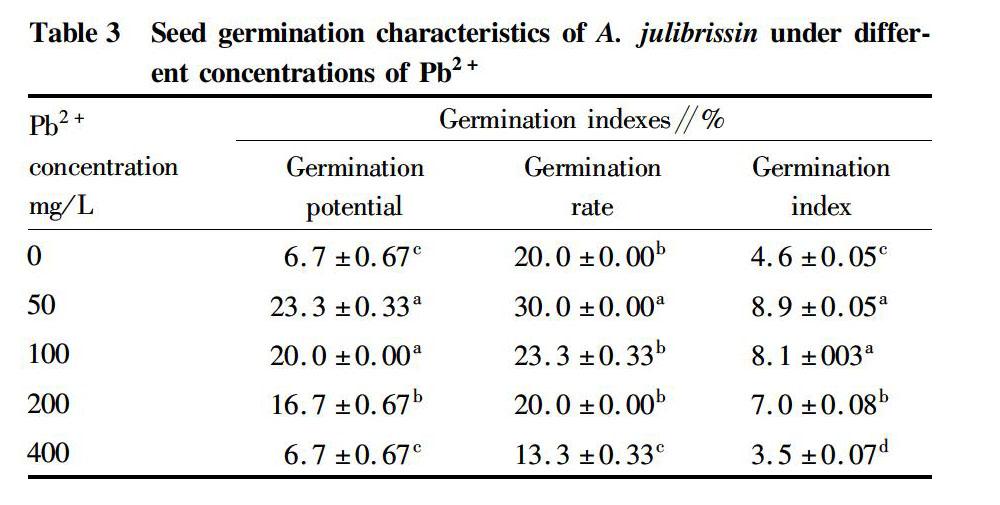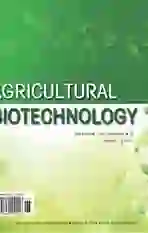Effect of Heavy Metal Stress on Seed Germination of Albizia julibrissin
2021-08-02YingZHAOXuhuiLIULinglingZHENGLinhongCHENYongrongQIN
Ying ZHAO Xuhui LIU Lingling ZHENG Linhong CHEN Yongrong QIN



Abstract [Objectives] This study was conducted to investigate the effects of different heavy metal stresses on seed germination, in order to provide a theoretical basis for phytoremediation of soil heavy metal pollution.
[Methods]With the seeds of A. julibrissin as an experimental material, the germination test of A. julibrissin seeds under different concentrations of Cu2+, Zn2+ and Pb2+ was carried out. The germination potential, germination rate, germination index, radicle length, embryo length and other indexes were measured.
[Results] ① Different heavy metals had different effects on the germination of A. julibrissin seeds. Low concentrations of Cu2+, Zn2+ and Pb2+ stresses had certain promotion effects on the germination of A. julibrissin seeds, but high concentrations of Cu2+, Zn2+, Pb2+ stresses had obvious inhibitory effects on the germination of A. julibrissin seeds. ② There were obvious differences in the tolerance of A. julibrissin seeds to different metal ion stresses. According to the comparison of the average values of membership functions, the order of their tolerance to different heavy metal ions was: Zn2+>Cu2+>Pb2+.
[Conclusions]In the case of light pollution, the germination of A. julibrissin seeds was not inhibited, and the use of this plant for the remediation of lightly contaminated soil with heavy metals can also be considered.
Key words Heavy metal stress; Albizia julibrissin; Seed germination; Effect
Received: December 23, 2020 Accepted: February 24, 2021
Supported by Guangxi Natural Science Foundation (GKZ 0832273); Laboratory for Comprehensive Prevention and Control of Rocky Desertification in Karst Areas in Northwest Guangxi (XZF[2016]91); Hechi University Masters Professional Degree Construction Fund (2016HJA007).
Ying ZHAO (1999-), female, P. R. China, major: biology.
*Corresponding author. E-mail: hcxyqyr@126.com.
Albizia julibrissin Durazz is native to China, Japan, Korea and other places. It has certain tolerance to heavy metals[1], and can be used for phytoremediation of soil pollution by heavy metals and has high ecological benefits.
Zhou[2] used Leucaena leucocephala as an experimental material to carry out cadmium and copper stress pot experiments, and found that L. leucocephala had strong tolerance to both. Low concentrations of Cd2+ and Cu2+ had certain promoting effects on the growth of L. leucocephala, while high concentrations had inhibitory effects on its growth. Li et al.[3] mixed tailings, red soil and pig manure in different proportions for pot experiment of L. leucocephala, and determined the contents of copper, zinc, lead, and cadmium in the pot substrate (soil) and plant samples, and the chlorophyll content of L. leucocephala. The results showed that the various growth indexes of L. leucocephala decreased with the increase of tailing content, and tailings could inhibit its growth. Adding certain amounts of red soil or pig manure could promote L. leucocephala growth.
Zhou[4] mixed garden soil and copper sulfate solution in different proportions, and carried out cultivation experiments on the seedlings of A. julibrissin. After 45 d, the plant height, root length, MDA and other indexes of the seedlings were measured, and the effects of different concentrations of Cu2+ on the growth of A. julibrissin seedlings were analyzed. The results showed that with the increase of copper ion concentration, the plant height and the fresh weight curves of the aboveground and the underground parts of A. julibrissin showed an inverted "U" shape. Among them, the plant height and the fresh weight of the aboveground part reached their maximum values at the Cu2+ concentration of 400 mg/kg. Under the stress of different concentrations of copper ions, the MDA in the leaves of A. julibrissin was positively correlated with Cu2+ concentration, and the differences reached a significant level compared with the control group; and the relative content of MDA in the roots of A. julibrissin showed an inverted U-shaped curve with the increase of Cu2+ concentration, but overall, the relative content of MAD showed a decreasing trend, indicating that the roots of A. julibrissin had a certain tolerance to heavy metal Cu2+, while Cu2+ would cause certain damage to the leaves of A. julibrissin.
Zeng[5] mixed garden soil and copper tailings in a certain proportion as a cultivation substrate, and carried out cultivation experiments on seedlings of Sophora japonica, A. julibrissin, Albizia kalkora and Koelreuteria bipinnata Franch. var. integrifoliola (Merr.) T. Chen, during which the Cu2+ contents of the aboveground and underground parts of the seedlings and some morphological and physiological indexes were determined. The results showed that the tolerance of different plants to Cu2+ was quite different, usually low concentrations of Cu2+ promoted plant growth, and high concentrations of Cu2+ inhibited plant growth; and compound cultivation of S. japonica, A. julibrissin and A. kalkora effectively improved soil enzyme activity, and the enrichment effect on heavy metals was better than single cultivation.
Soil heavy metal pollution has the characteristics of difficult degradation and high risk, and is extremely harmful to human health[6]. In recent years, Chinas industrial structure has undergone major adjustments. Some enterprises with high energy consumption and heavy pollution have been shut down and transferred. However, due to historical reasons, many abandoned factories and mining wastelands have serious heavy metal pollution problems and urgently need to be treated[7]. Among many environmental remediation technologies, phytoremediation has been recognized by the public as a safe and reliable soil remediation technology, and has been gradually promoted and applied[8]. At present, there are many reports on the cultivation of A. julibrissin[9], but there are few reports on the study of its heavy metal tolerance[4-5]. Therefore, it is necessary to conduct in-depth research on the seed germination and seedling growth of A. julibrissin under heavy metal stress to explore the possibility of using it to remediate heavy metal contaminated soil, so as to provide a theoretical reference for the phytoremediation of heavy metal contaminated soil.
Materials and Methods
Experimental materials
The material used in this study was the seeds of A. julibrissin, which were purchased online from the Jiayuan Ginkgo Forest Seed Store in Jiangsu.
Experimental methods
Seed screening
Full, intact and healthy seeds of A. julibrissin were screened according to the conventional method to ensure that the purity and shape of A. julibrissin seeds reached 98% and 99.6%, respectively.
A vernier caliper was used to measure the length, width and thickness (the thickest part of the A. julibrissin seeds) of 30 randomly selected A. julibrissin seeds with accuracy of 0.01 mm, and the average value was calculated[10]. The 100-seed weight and 1 000-seed weight of seeds were determined according to the national standard Rules for forest tree seed testing[11]. Specifically, 100 seeds were randomly selected and weighed with an electronic analytical balance, and the determination was repeated three times to obtain the 100-seed weight. The 1 000-seed weight of seeds was determined and calculated in the same way.
Seed pretreatment
The TTC method was used to determine the seed vitality[12]. The seeds of A. julibrissin with seed vitality of more than 86% were selected for experimentation. The A. julibrissin seeds were immersed in 98% concentrated sulfuric acid for 30 s together with gauze for separation, then taken out together with the gauze, and washed with water to remove the concentrated sulfuric acid attached to the seeds[14]. The treated seeds were placed in deionized water at 70 ℃, and the water temperature was allowed to decrease naturally. The water was changed every 6 h, and the seeds were taken out after being soaked for 2 d. The swollen A. julibrissin seeds were soaked with 0.1% potassium permanganate solution for 15 min, then rinsed with tap water until there was no obvious redness, and finally rinsed with deionized water. The excess water was absorbed using qualitative filter paper[15].
Seed germination test
The concentration gradients of heavy metal ions for different treatments were designed according to the national soil three-level standards[16]. Double layers of qualitative filter paper were placed as a germination bed in plastic petri dishes of 9 cm in size, and 20 treated A. julibrissin seeds were put in each dish. Then, 3 ml of the prepared heavy metal solutions were added into the petri dishes, and each treatment was repeated 3 times. To prevent the seeds from becoming moldy and rot, the filter paper was replaced every 48 h. An artificial climate incubator was used to simulate the natural environment to cultivate the seeds. The culture conditions were set as follows: 12 h of day time (light time) with a temperature at 30 ℃ and humidity of 80%, and 12 h of night time (dark time) with a temperature at 25 ℃ and humidity of 80%. The seeds of A. julibrissin were observed every 24 h for recording the number of germinated seeds (the length of the embryos was greater than or equal to half the length of the seed as the standard for seed germination), the length of radicle and the length of embryos, and waste liquids in the dishes were removed, followed by the addition of new ones of different concentrations to keep the concentration of the heavy metal solution of each treatment in the petri dish unchanged. If no seeds germinated in the petri dish for 10 consecutive days, the germination test would be deemed to have ended.
Determination indexes and methods
Determination indexes
After the germination test, the radicle length and embryo length of the A. julibrissin seeds were measured, and their germination potential, germination rate, and germination index were measured. The relative value of each index was calculated. Seed viability is used as the basis for judging whether seeds can germinate, and generally measured by germination rate and germination potential[17]. Germination potential refers to the percentage of seeds germinated in the test seeds from the initial stage of germination to the most efficient period of germination. Germination potential is positively correlated with the order of seed emergence, that is, the higher the germination potential is, the more orderly the seeds will emerge. The level of germination rate represents the quality of seed embryos[18], and the germination index can comprehensively reflect the germination of seeds. After the germination test, 15 A. julibrissin seeds were randomly selected from different treatments[19], and the radicle and embryo lengths were measured with a vernier caliper. On the 3rd d of the germination test, the seed germination potential was measured, and on the 7th d of the germination test, the seed germination rate was measured[20].
Determination methods
Germination rate (%) = The number of seeds germinated in the dish on the 3rd d/Total number of seeds in the dish×100%[20];
Germination potential (%) = The number of seeds germinated in the dish on the 7th d/Total number of seeds in the dish×100%[20];
Germination index (GI)=∑(Gt/Dt)[22] (Gt is the number of A. julibrissin seeds germinated at the tth d, and Dt is the number of germination days);
Relative germination potential (%) = The germination potential of the seeds in the dish on the 3rd d/The germination potential of the control group×100%[21];
Relative germination rate (%) = The germination rate of the seeds in the dish on the 7th d/The germination rate of the control group×100%[21];
Relative radicle length (%) = The radicle length of the experimental group/The radicle length of the control group×100%[21];
Relative embryo length (%) = The embryo length of the experimental group/The embryo length of the control group × 100%[21].
Comprehensive evaluation of the tolerance of A. julibrissin to heavy metals
The membership function method was used to comprehensively evaluate the tolerance of A. julibrissin seeds under stresses of heavy metal copper, zinc, and lead[22]. The specific membership function value of the seed relative index under heavy metal stress was calculated using the formula X(ij) = ( Xj-Xjmin)/( Xjmax-Xjmin)[23]. In the formula, Xj is the determined value of a certain index of A. julibrissin, Xjmin is the minimum of corresponding index, and Xjmax is the maximum of corresponding index. Then, the membership values of each index under different heavy metal concentrations were first summed and then averaged, and finally the average values of the membership functions of all indexes were calculated. The average value of the membership function was used to determine the resistance and tolerance of the A. julibrissin seeds to three different heavy metals during the germination period, and the resistance and tolerance of seeds to heavy metals was positively correlated with the average value of the membership function.
Data processing analysis
The experimental data were statistically processed by Excel 2010, and differences were analyzed by SPSS 24.0 software.
Results and Analysis
Effects of different heavy metal stresses on germination potential, germination rate and germination index of seeds
The effects of different concentrations of Cu2+, Zn2+, Pb2+ on the germination of A. julibrissin seeds are shown in Table 1, Table 2, and Table 3. Although the effects of different heavy metal ion stresses on the germination of A. julibrissin seeds were different, their common characteristics were that low concentrations promoted the germination of A. julibrissin seeds to a certain extent, and high concentrations inhibited the seed germination.
Effects of different heavy metal stresses on the growth of radicle and embryos of A. julibrissin seeds
The effects of different heavy metal stresses on the growth of seed radicle and embryos of A. julibrissin are shown in Table 4, Table 5 and Table 6. It can be seen that the appropriate concentrations of heavy metal ions promoted the growth of the seed radicle of A. julibrissin, but the high concentrations of heavy metal stresses had significant inhibitory effects on the growth of the radicle; and heavy metal ions had inhibitory effects on the growth of the seed embryo s of A. julibrissin, and with the concentrations of heavy metal ions increasing, the inhibitory effects became more obvious.
Comprehensive evaluation of tolerance of A. julibrissin to different heavy metals
The relative indexes such as the relative germination potential and relative germination rate of A. julibrissin seeds were used as evaluation criteria. The membership function method was used to analyze the tolerance of A. julibrissin under different concentrations of heavy metal stress. The statistical results are shown in Table 7 to Table 9. It can be seen that the average values of the membership functions of various relative indexes of the A. julibrissin seeds under the stresses of different heavy metals Cu2+, Zn2+ and Pb2+ were 0.610 9, 2.482 1 and 1.297 2, respectively. According to the membership function values, it can be known that the tolerance of the A. julibrissin seeds to the three heavy metal ions ranked as Zn2+>Pb2+>Cu2+.
Discussion and Conclusions
For the germination of general seeds, the germination potential is positively correlated with the order of seedling emergence. The higher the germination potential is, the more orderly the germination of seeds will be. The germination rate reflects the germination quality of seeds, and the germination index reflects the comprehensive characteristics of seed germination.
Under the stress of heavy metal Cu2+, the germination potential, germination rate and germination index of A. julibrissin seeds all increased first and then decreased, which is similar to the research of Zhou[4]. High concentrations of heavy metal ions inhibit seed germination and seed viability, which may be due to heavy metals interfering with the physiological metabolism of seeds[24]. Related studies have found that a high concentrations of Zn2+ can inhibit the production of proteases, and reduce the activity of amylase and the respiration of seeds, resulting in insufficient ATP required for seed germination, thereby inhibiting seed germination[25]; and a high concentration of Pb2+ will affect the germination process and regularity of seeds.
According to reports, during seed germination, embryo growth is only related to cell elongation, while radicle growth is not only related to cell elongation but also cell division[26]. High concentrations of Cu2+ inhibited cell division, so it inhibited the growth of the radicle of A. julibrissin seeds. High concentrations of Pb2+ inhibited the growth of seed radicle and embryos, which might be related to the effect of Pb2+ on dehydrogenase activity in seeds[27].
The mechanism of heavy metals inhibiting seed germination is relatively complicated. In particular, the effect of multiple heavy metal compound stress on seed germination is a problem that deserves more attention. Many problems need to be studied in depth to reveal their true causes.
Based on the above experimental data and analysis and discussion, the following conclusions could be preliminarily obtained:
① Low concentrations of Cu2+, Zn2+, Pb2+ stresses promoted the germination of A. julibrissin seeds to a certain extent, but the stresses of high concentrations of Cu2+, Zn2+, Pb2+ obviously inhibited the germination of A. julibrissin seeds.
② There were obvious differences in the tolerance of A. julibrissin seeds to different metal ion stresses. According to the comparison of the average values of membership functions, the order of their tolerance to different heavy metal ions was: Zn2+>Cu2+>Pb2+.
③ Because the germination of A. julibrissin seeds was not inhibited under light pollution conditions, it is also possible to use this plant to remediate soil lightly contaminated by heavy metals.
References
[1] CHEN BY. Choice of tree species of Changsha high-tech zone based on grey system theory[D]. Changsha: Central South University of Forestry and Technology, 2019. (in Chinese)
[2] ZHOU Y. Tolerance and accumulation characteristics of cadmium, cooper in Leucaena glauca L.[D]. Yaan: Sichuan Agricultural University, 2014. (in Chinese)
[3] LI ZQ, YANG JG, XIONG JF, et al. Effect of lead-zinc mine tailings on the growth of Leucaena leucocephala[J]. Bulletin of Agricultural Science and Technology, 2013(2): 95-100. (in Chinese)
[4] ZHOU SY. Effects of different concentrations of Cu2+ stress on the growth and MDA of Albizia julibrissin[J]. Hebei Farm Machinery, 2016(7): 48-49. (in Chinese)
[5] ZENG CY. Study on resistance mechanism and remediation potential of three woody legumes to ore sand of copper tailings[D]. Nanchang: Jiangxi University of Finance and Economics, 2017. (in Chinese)
[6] ZHOU JJ, ZHOU J, FENG RG, et al. Current status of soil heavy metal pollution in China and its control strategy[J]. Bulletin of Chinese Academy of Sciences, 2014, 29(3): 315-320, 350, 272. (in Chinese)
[7] ZHANG X. Study on harm and technology of heavy metal pollution in soil[J]. China Resources Comprehensive Utilization, 2019, 37(11): 89-90, 93. (in Chinese)
[8] CHEN L, HU MY. Study progress on the phytoremediation technology in polluted soil by heavy metals[J]. Chemistry & Bioengineering, 2014, 31(4): 6-8. (in Chinese)
[9] MEI F. Albizia julibrissin cultivation technology and garden application[J]. Zhongguo Yuanyi Wenzhai, 2016, 32(6): 170-172. (in Chinese)
[10] LI W, ZHOU P, ZHOU XB, et al. Geographic variation in seed traits of different Zenia insignis provenances[J]. Journal of South China Agricultural University, 2016, 37(4): 69-74. (in Chinese)
[11] ZHANG RJ. Thoughts on application of "GB2772-1999 Rules for forest tree seed testing"[J]. The Journal of Hebei Forestry Science and Technology, 2012(4): 72-75. (in Chinese)
[12] YU SL, PI S. A study on biochemical test of seed vaibility for 23 kinds of tropical and subtropical tree species[J]. Seed, 1994(6): 4-9. (in Chinese)
[13] LIU YL, DAI FF, WU L, et al. Optimum conditions for the seed viability staining of five species of tropical trees[J]. Journal of Hainan Normal University: Natural Science, 2018, 31(4): 441-447. (in Chinese)
[14] YANG Q, TANG HH, YANG Y, et al. Effect of different treatments on seed germination of Acacia cultri formis[J]. Seed, 2018, 37(11): 93-96. (in Chinese)
[15] SU XM, LI SC, SUN HL, et al. Effects of different hot water treating approach on the germination of 14 kinds of hard seeds[J]. Seed, 2019, 38(1): 76-79, 85. (in Chinese)
[16] YU L. Research on environmental criteria and standard system of soil heavy metals in Shandong Province[D]. Qufu: Shandong Normal University, 2015. (in Chinese)
[17] CHEN W. Effects of heavy metal stress on the growth, development and physiological characteristics of turfgrass[D]. Lanzhou: Gansu Agricultural University, 2014. (in Chinese)
[18] ZHANG FL, ZHAO XY, XU JB, et al. Study on the determination and calculation standard of indoor germination rate of Chinese cabbage[J]. Journal of Changjiang Vegetables, 1996(7): 30-31. (in Chinese)
[19] GAO FF. The effects of Cu, Zn, Cd and Pb on the growth of three leguminous plants and the metal-absorption abilities of the plants[D]. Shenyang: Northeastern University, 2008. (in Chinese)
[20] HE LS. The preliminary study on methods for determination of rice seed vigor[D]. Hangzhou: Zhejiang A & F University, 2018. (in Chinese)
[21] ZHAO YW, ZHENG Y, DUAN SR, et al. Effects of heavy metal stress on the germination and growth of two pasture seeds in the Qinghai-Tibet plateau[J]. Heilongjiang Animal Science and Veterinary Medicine, 2019(5): 104-109. (in Chinese)
[22] YU XJ, ZHANG JW, PAN TT, et al. Effects of heavy metals: Copper, cadmium and lead on the seed germination and seedling growth of leguminous forage[J]. Acta Agrestia Sinica, 2015, 23(4): 793-803. (in Chinese)
[23] ZHANG YJ, WANG Q, LONG YH, et al. Effects of Cu2+ stress on the seed germination and Cu-tolerance evaluation of industrial hemp[J]. Plant Fiber Sciences in China, 2018, 40(4): 183-191. (in Chinese)
[24] WANG WX, CAO CY, CUI ZB, et al. Copper enrichment from contaminated soil by alfalfa and its physiological response[J]. Journal of Northeastern University: Natural Science, 2006, 27(10): 1161-1164. (in Chinese)
[25] MIAO MS, ZHU YY, CAO MX, et al. The influence of lead on the bourgeon and development of Zea mays[J]. Journal of Shandong Normal University: Natural Science, 2003, 18(1): 82-84. (in Chinese)
[26] LIU DY, WANG YB. Effects of Cu and As on germination and seedling growth of crops[J]. Chinese Journal of Applied Ecology, 2002, 13(2): 179-182. (in Chinese)
[27] LIU MM, LI JN, SHEN YX, et al. Effects of Pb2+ pollution on the seed germination and seedling growth of Italian ryegrass[J]. Pratacultural Science, 2007, 24(1): 52-54. (in Chinese)
杂志排行
农业生物技术(英文版)的其它文章
- Anti-inflammatory Activity and Mechanism of Total Flavonoids from the Phloem of Paulownia elongate S.Y. Hu in LPS-stimulated RAW264.7 Macrophages
- Comparative Genomic Analysis of Boron Transport Gene Family in Arabidopsis and Five Crops
- Effects of Different Water-saving Irrigation Methods on Fruit Quality and Yield of Snow Melon
- Field Control Effects and Crop Safety Assessment of Triazole Fungicides on Apple Rust
- Effects of Acetylacetone Solution Soaking on Agrobacterium-transformed Maize Seed Buds
- Effects of Meteorological Factors on Overwintering Ability, Yield and Quality of Forage Rape
